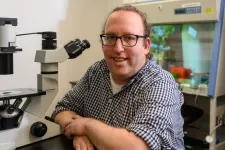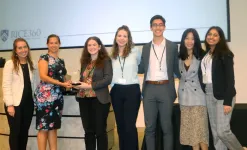(Press-News.org) CLEVELAND, Ohio (May 8, 2023)—As the population continues to age, there is greater focus on bone health and minimizing fractures to maintain mobility. A new study suggests that various types of hormone therapies not only increase lumbar spine bone mineral density (BMD) in postmenopausal women but also protect against bone loss, even after hormones have been discontinued. Study results are published online in Menopause, the journal of The North American Menopause Society (NAMS).
Osteoporosis is a common debilitating condition, with approximately 14 million cases in the United States alone. Characterized by decreased BMD and an increased risk of bone fragility that results in pain, fracture, and disability, it is often associated with estrogen deficiency. This explains why postmenopausal women have a greater risk of developing osteoporosis than older men.
Hormone therapy (HT), including estrogen-only and estrogen-progestogen combinations, is widely used for the prevention and management of osteoporosis, although there have been conflicting studies about the lingering benefits after the hormone use is discontinued.
In this study, which is based on real-world data from more than 6,000 postmenopausal women involved in the national Health and Nutrition Examination Survey, researchers sought to evaluate the associations of various types of hormone preparations with BMD, postmenopausal bone loss (osteopenia), and postmenopausal osteoporosis. They also explored the withdrawal effect of HT. Multiple therapies were studied, including oral contraceptive pills, estrogen-only pills, estrogen-progestogen combination pills, and estrogen-only patches.
On the basis of the results, researchers concluded that all the therapies evaluated increased lumbar spine BMD in postmenopausal women. Except for the estrogen-only patches, all forms of HT additionally provided protection against osteopenia. These benefits persisted even after the hormone preparations were discontinued. No association, however, was found between HT and osteoporosis prevalence.
Study results are published in the article “Association of hormone preparations with bone mineral density, osteopenia and osteoporosis in postmenopausal women: data from National Health and Nutrition Examination Survey 1999-2018.”
“This large cross-sectional study showed that current and prior use of multiple types of hormone therapies, including combined hormone contraception used in premenopausal women and menopause hormone therapies, were linked with bone protection in postmenopausal women and that these effects persisted after discontinuation of treatment. Additional study is needed to investigate the influence of time since stopping hormone therapy as well as the differential effects of various doses and formulations on bone health, including fracture risk,” says Dr. Stephanie Faubion, NAMS medical director.
For more information about menopause and healthy aging, visit www.menopause.org.
Founded in 1989, The North American Menopause Society (NAMS) is North America’s leading nonprofit organization dedicated to promoting the health and quality of life of all women during midlife and beyond through an understanding of menopause and healthy aging. Its multidisciplinary membership of 2,000 leaders in the field—including clinical and basic science experts from medicine, nursing, sociology, psychology, nutrition, anthropology, epidemiology, pharmacy, and education—makes NAMS uniquely qualified to serve as the definitive resource for health professionals and the public for accurate, unbiased information about menopause and healthy aging. To learn more about NAMS, visit www.menopause.org.
END
Hormone therapy increases lumbar spine bone mineral density, protects against bone loss
New study confirms that the benefits of hormones on bone health persist in postmenopausal women even after therapies are discontinued
2023-05-08
ELSE PRESS RELEASES FROM THIS DATE:
NIH Trailblazer Award will use advanced AI to improve outcomes for heart patients
2023-05-08
Pacemakers and other implantable devices that restore normal heart rhythms have saved millions of lives.
In some patients, a pacemaker or implantable cardioverter defibrillator modified for “cardiac resynchronization therapy,” or CRT, can dramatically improve heart failure by synchronizing the heart’s pumping function. Unfortunately, many people don’t respond to CRT and of those who do, some don’t realize its full potential — including increased exercise capacity and staying out of the hospital.
CRT can save or change many more lives, says Miaomiao Zhang, an assistant professor at the University of Virginia School ...
New probe aids novel findings on cell functions
2023-05-08
Collaborative research at the University of Cincinnati has developed a new probe to better study cells that has already led to new knowledge about certain cellular processes.
UC’s Jiajie Diao, PhD, and Yujie Sun, PhD, are lead authors on new research published May 4 in ACS Sensors.
Focus on endolysosomes
The team’s research focused on organelles, or specialized structures that perform various jobs inside cells, called endolysosomes. Lysosomes are organelles that act as the “recycling center” of the cell, reusing ...
Model aims to help first responders reach accident sites faster
2023-05-08
Researchers at North Carolina State University have developed a complex model to improve how quickly first responders – such as police and EMTs – reach the scene of vehicle accidents. In computational testing, the model outperformed the existing techniques for getting first responders to accident sites quickly.
“The goal was to figure out the most efficient way to get first responders to an accident,” says Leila Hajibabai, corresponding author of a paper on the work and an assistant professor in NC State’s Edward P. Fitts Department of Industrial and Systems Engineering. “Where should first responders be based ...
From Azerbaijan to China: BGI Genomics promotes thalassemia awareness worldwide
2023-05-08
Thalassemia (thal-uh-SEE-me-uh) is an inherited blood disorder that affects about 300 million people worldwide. Treatments for moderate to severe thalassemia include frequent blood transfusions, chelation therapy to remove excess iron from the blood, and hematopoietic stem cell transplantation (HSCT).
In line with the theme of this year's International Thalassemia Day – "Be Aware. Share. Care: Strengthening Education to Bridge the Thalassemia Care Gap", BGI Genomics will co-host an event with the Shenzhen Municipal Health Commission for thalassemia patients and their family members on May 6, 2023, in Shenzhen, China, providing tips on ...
University of Minnesota to lead new $20M AI Institute focusing on climate-smart agriculture and forestry
2023-05-08
The University of Minnesota Twin Cities announced that it will receive a $20 million grant over five years from the National Science Foundation (NSF) and the U.S. Department of Agriculture’s (USDA) National Institute of Food and Agriculture (NIFA) to lead a new National Artificial Intelligence Research Institute.
Researchers at the AI Institute for Climate-Land Interactions, Mitigation, Adaptation, Tradeoffs and Economy (AI-CLIMATE) aim to leverage artificial intelligence (AI) to create more climate-smart practices that will absorb and store carbon while simultaneously boosting the economy in the agriculture and forestry industries.
The new ...
Hispanic women face inequities affecting maternal health outcomes
2023-05-08
DALLAS, May 8 2023 — Cardiovascular disease is the No. 1 killer of new moms.[1] The American Heart Association, through the new campaign, “My health is our health”/ “Mi salud es nuestra salud” is raising awareness among Hispanic/ Latina moms, especially during pregnancy, about the importance of managing their blood pressure. On average, about one in every 16 Hispanic women aged 20 and older have coronary heart disease, the most common type of heart disease.[2]
Hispanic/Latina mothers hold a special place in their homes when it comes to family decisions. They are considered the head of the family for their key role in raising children and ...
Mirror, mirror: A new way to recognize reverse-image molecules
2023-05-08
Recognizing and separating enantiomers is a difficult task for chemical engineers — one might say it gives them a bit of a headache.
Enantiomers are molecules with virtually identical compositions that mirror one another, like a left and right hand. In chemistry, this property is called chirality. Despite the similarities in their makeup, so-called left- and right-handed enantiomers often exhibit very different properties. Sometimes a drug has an enantiomer that causes undesirable effects. For example, certain drugs have one enantiomer that can cause a headache, ...
Experimental model gets cells to behave as they would in utero
2023-05-08
HOUSTON – (May 8, 2023) – Many birth defects and spontaneous abortions occur during the embryonic development stage known as neurulation, yet we have very little insight into how this critical developmental process unfolds in humans.
The Rice University lab of Aryeh Warmflash has received a five-year, $1.9 million grant from the National Institutes of Health to optimize and develop experimental cell models that can shed light on the self-organizing processes by which ectodermal ...
U of M researchers develop technique for rapid detection of neurodegenerative diseases like Parkinson’s and Chronic Wasting Disease
2023-05-08
University of Minnesota Twin Cities researchers have developed a groundbreaking new diagnostic technique that will allow for faster and more accurate detection of neurodegenerative diseases. The method will likely open a door for earlier treatment and mitigation of various diseases that affect humans, such as Alzheimer's and Parkinson's, and similar diseases that affect animals, such as chronic wasting disease (CWD).
Their new study is published in Nano Letters, a premier journal in the field of nanotechnology published by the American Chemical Society.
“This paper mainly ...
Rice University students design congenital hypothyroidism test for newborns
2023-05-08
HOUSTON – (May 8, 2023) – For newborns with congenital hypothyroidism, early diagnosis spells the difference between a normal, healthy life and lifelong disability.
After learning about the heavy toll the disease takes on children born in parts of the world where testing is limited or absent, a team of Rice University students came together to develop a low-cost screening tool that can detect abnormally high thyroid-stimulating hormone (TSH) levels indicative of dysfunction.
The point-of-care, paper-based test developed ...
LAST 30 PRESS RELEASES:
B cells transiently unlock their plasticity, risking lymphoma development
Advanced AI dodel predicts spoken language outcomes in deaf children after cochlear implants
Multimodal imaging-based cerebral blood flow prediction model development in simulated microgravity
Accelerated streaming subgraph matching framework is faster, more robust, and scalable
Gestational diabetes rose every year in the US since 2016
OHSU researchers find breast cancer drug boosts leukemia treatment
Fear and medical misinformation regarding risk of progression or recurrence among patients with breast cancer
Glucagonlike peptide-1 receptor agonists and asthma risk in adolescents with obesity
Reviving dormant immunity: Millimeter waves reprogram the immunosuppressive microenvironment to potentiate immunotherapy without obvious side effects
Safety decision-making for autonomous vehicles integrating passenger physiological states by fNIRS
Fires could emit more air pollution than previously estimated
A new way to map how cells choose their fate
Numbers in our sights affect how we perceive space
SIMJ announces global collaborative book project in commemoration of its 75th anniversary
Air pollution exposure and birth weight
Obstructive sleep apnea risk and mental health conditions among older adults
How talking slows eye movements behind the wheel
The Ceramic Society of Japan’s Oxoate Ceramics Research Association launches new international book project
Heart-brain connection: international study reveals the role of the vagus nerve in keeping the heart young
Researchers identify Rb1 as a predictive biomarker for a new therapeutic strategy in some breast cancers
Survey reveals ethical gaps slowing AI adoption in pediatric surgery
Stimulant ADHD medications work differently than thought
AI overestimates how smart people are, according to HSE economists
HSE researchers create genome-wide map of quadruplexes
Scientists boost cell "powerhouses" to burn more calories
Automatic label checking: The missing step in making reliable medical AI
Low daily alcohol intake linked to 50% heightened mouth cancer risk in India
American Meteorological Society announces Rick Spinrad as 2026 President-Elect
Biomass-based carbon capture spotlighted in newly released global climate webinar recording
Illuminating invisible nano pollutants: advanced bioimaging tracks the full journey of emerging nanoscale contaminants in living systems
[Press-News.org] Hormone therapy increases lumbar spine bone mineral density, protects against bone lossNew study confirms that the benefits of hormones on bone health persist in postmenopausal women even after therapies are discontinued







